horn BUICK CENTURY 1993 Owners Manual
[x] Cancel search | Manufacturer: BUICK, Model Year: 1993, Model line: CENTURY, Model: BUICK CENTURY 1993Pages: 324, PDF Size: 17.58 MB
Page 65 of 324
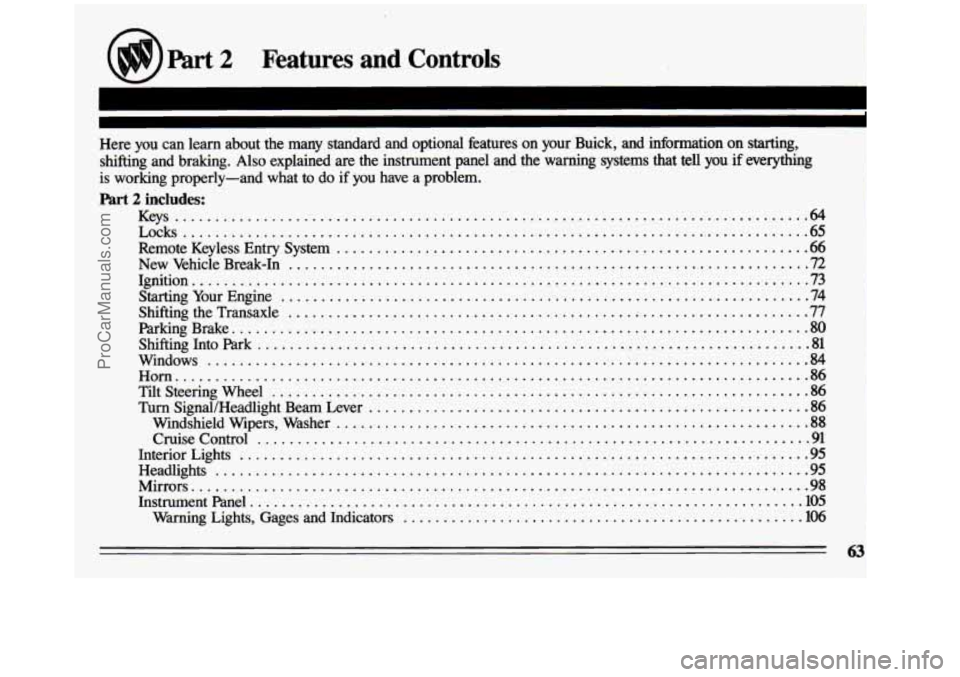
n
part 2 Features and Controls
Here you can learn about the many standard and optional features on your Buick. and informat\
ion on starting.
shifting and braking . Also explained are the instrument panel and the warning systems that tell you if everything
is working properly-and what to do if you have a problem .
Part 2 includes:
Keys ........................................................................\
........
Locks ........................................................................\
...... 65
Remote Keyless Entry System ........................................................... 66
New Vehicle Break-In ................................................................. 72
Ignition ........................................................................\
..... 73
Starting Your Engine .................................................................. 74
Shifting the Transaxle ........................................... : ..................... 77
parking Brake ........................................................................\
80
ShiftingIntoPark ..................................................................... 81
Windows ........................................................................\
... 84
Horn ........................................................................\
....... 86
TiltSteeringWheel ................................................................... 86
Turn Signal/Headlight Beam Lever ....................................................... 86
Windshield Wipers, Washer ........................................................... 88
CruiseControl ..................................................................... 91
InteriorLights ....................................................................... \
95
Headlights ........................................................................\
.. 95
Mirrors ........................................................................\
..... 98
Instrument Panel ..................................................................... 105
Warning Lights, Gages and Indicators .................................................. 106
63
ProCarManuals.com
Page 88 of 324
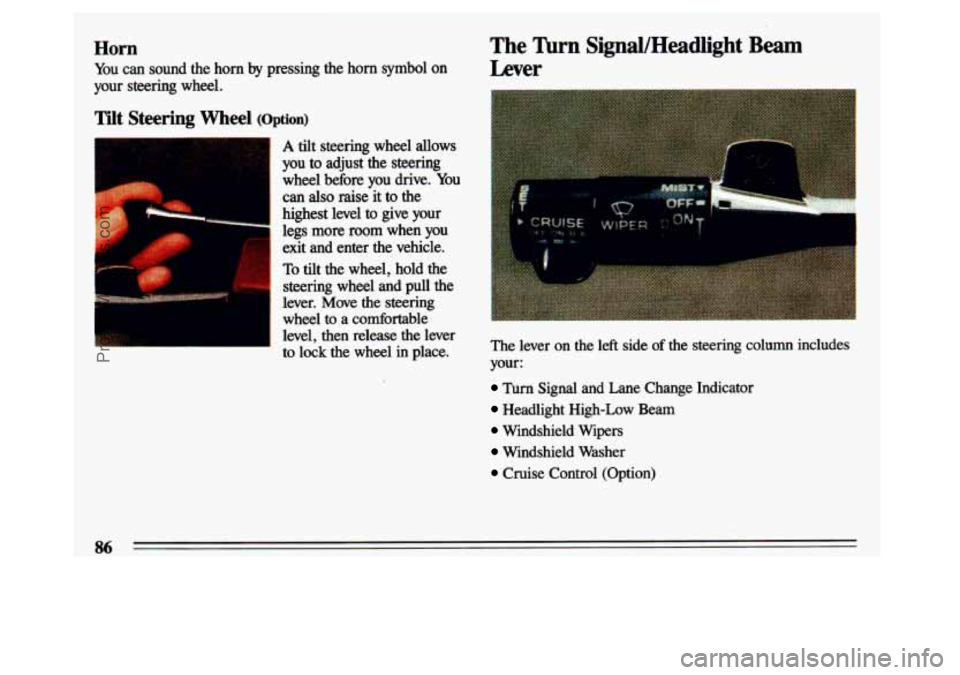
Horn
You can sound the horn by pressing the horn symbol on
your steering wheel.
Tilt Steering Wheel (Option)
b
-.
A tilt steering wheel allows
you
to adjust the steering
wheel before you drive. You
can
also raise it to the
highest level
to give your
legs more room when you
exit and enter the vehicle.
To tilt the wheel, hold the
steering wheel and pull the
lever. Move the steering
wheel to a comfortable
level, then release the lever
to lock the wheel in place.
The I’urn SignaUHeadlight Beam
Lever
The lever on the left side of the steering column includes
your:
Turn Signal and Lane Change Indicator
Headlight High-Low Beam
Windshield Wipers
Windshield Washer
Cruise Control (Option)
86
ProCarManuals.com
Page 155 of 324
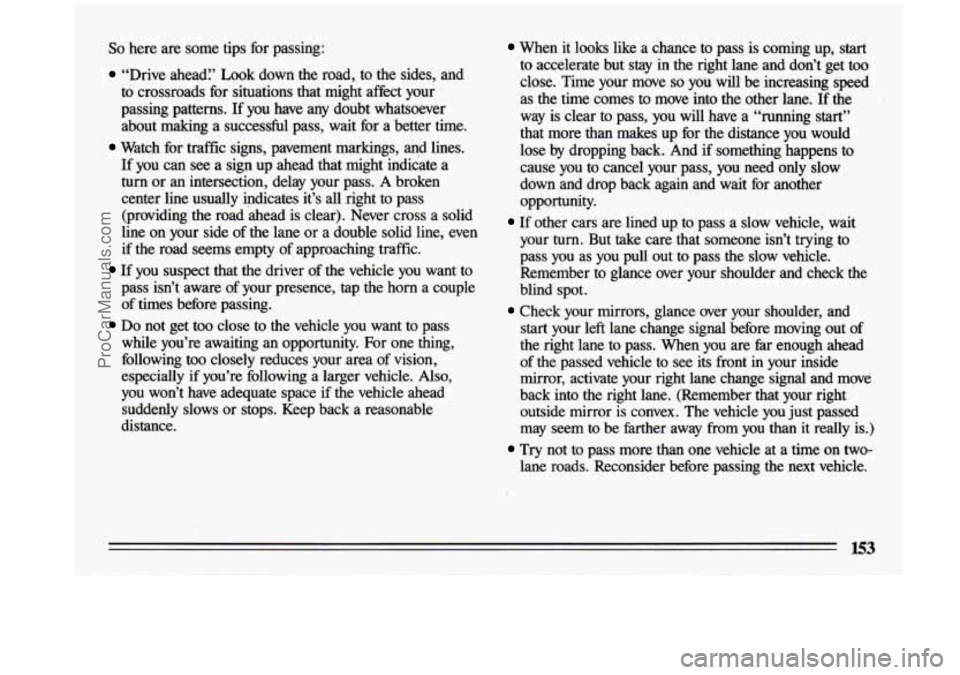
So here are some tips for passing:
“Drive ahead:’ Look down the road, to the sides, and
to crossroads for situations that might affect your
passing patterns. If you have any doubt whatsoever
about making a successful pass, wait for a better time.
Watch for traffic signs, pavement markings, and lines.
If you can
see a sign up ahead that might indicate a
turn or an intersection, delay your pass. A broken
center line usually indicates it’s
all right to pass
(providing the road ‘ahead is clear). Never cross a solid \
line on your side of the lane or a double solid line, even
if the road seems empty of approaching traffic.
If you suspect that the driver of the vehicle you want to
pass isn’t aware of your presence, tap the horn a couple
of times before passing.
Do not get too close to the vehicle you want to pass
while you’re awaiting
an opportunity. For one thing,
following too closely reduces your area
of vision,
especially if you’re following a larger vehicle. Also,
you won’t have adequate space if the vehicle ahead
suddenly slows or stops. Keep back a reasonable
distance.
When it looks like a chance to pass is coming up, start
to accelerate but stay in the right lane and don’t get too
close. Time your move
so you will be increasing speed
as the time comes to move into the other lane. If the
way is clear to pass,
you will have a “running start’’
that more than makes up for the distance you would
lose
by dropping back. And if something happens to
cause you to cancel your pass, you need only slow
down and drop back again and wait
for another
opportunity.
If other cars are lined up to pass a slow vehicle, wait
your turn. But take care that someone isn’t trying
to
pass you as you pull out to pass the slow vehicle.
Remember to glance over your shoulder and check the
blind spot.
start your left lane change signal before moving out of
the right lane to pass. When you are far enough ahead
of the passed vehicle to see its front
in your inside
mirror, activate your right lane change signal and move
back into
the right lane. (Remember that your right
outside mirror
is convex. The vehicle you just passed
may seem to be farther away from you
than it really is.)
Try not to pass more than one vehicle at a time on two-
lane roads. Reconsider before passing the next vehicle.
Check your mirrors, glance over your shoulder, and
ProCarManuals.com
Page 163 of 324
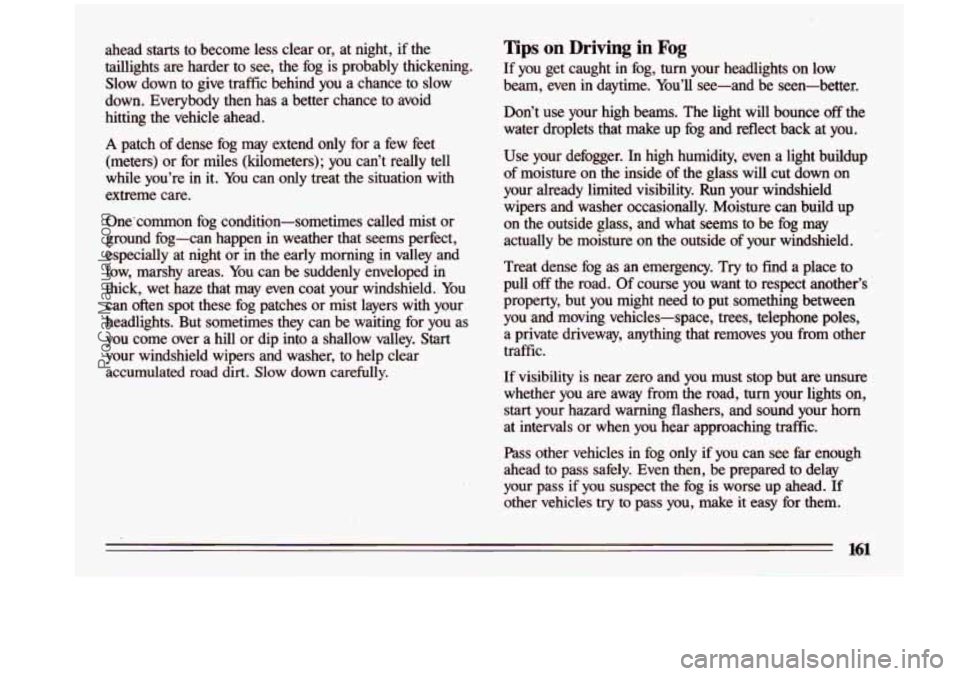
ahead starts to become less clear or, at night, if the
taillights are harder to see, the fog is probably thickening.
Slow down to give traffic behind you a chance to slow
down. Everybody then has a better chance to avoid hitting the vehicle ahead.
A patch of dense fog may extend only for a few feet
(meters) or for miles (kilometers); you can’t really tell
while you’re in it. You can only treat the situation with
extreme care.
One‘common fog condition-sometimes called mist or
ground fog-can happen in weather that seems perfect,
especially at night or
in the early morning in valley and
low, marshy areas. You can be suddenly enveloped in
thick, wet haze that may even coat your windshield. You
can often spot these fog patches or mist layers with your
headlights. But sometimes they can be waiting for you as
you come over a hill or dip into a shallow valley.
Start
your windshield wipers and washer, to help clear
accumulated
road dirt. Slow down carefully.
Tips on Driving in Fog
If you get caught in fog, turn your headlights on low
beam, even in daytime. You’ll see-and be seen-better.
Don’t use your high beams. The light will bounce
off the
water droplets that make up fog and reflect back at you.
Use your defogger. In high humidity, even a light buildup
of moisture on the inside of the glass will cut down on
your already limited visibility. Run your windshield
wipers and washer occasionally. Moisture can build up
on the outside glass, and what seems to be fog .may
actually be moisture on the outside
of your windshield.
Treat dense fog as an emergency.
Try to find a place to
pull off the road. Of course you want to respect another’s
property, but you might need to put something between
you and moving vehicles-space, trees, telephone poles,
a private driveway, anything that removes you from other
traffic.
If visibility is near zero and you must stop but
are unsure
whether you are away from the road, turn your lights on,
start your hazard warning flashers, and sound your horn
at intervals or when you hear approaching traffic.
Pass other vehicles in fog only if you can see far enough
ahead to pass safely. Even then, be prepared
to delay
your pass if you suspect the fog is worse up ahead.
If
other vehicles try to pass you, make it easy for them.
161
ProCarManuals.com
Page 269 of 324
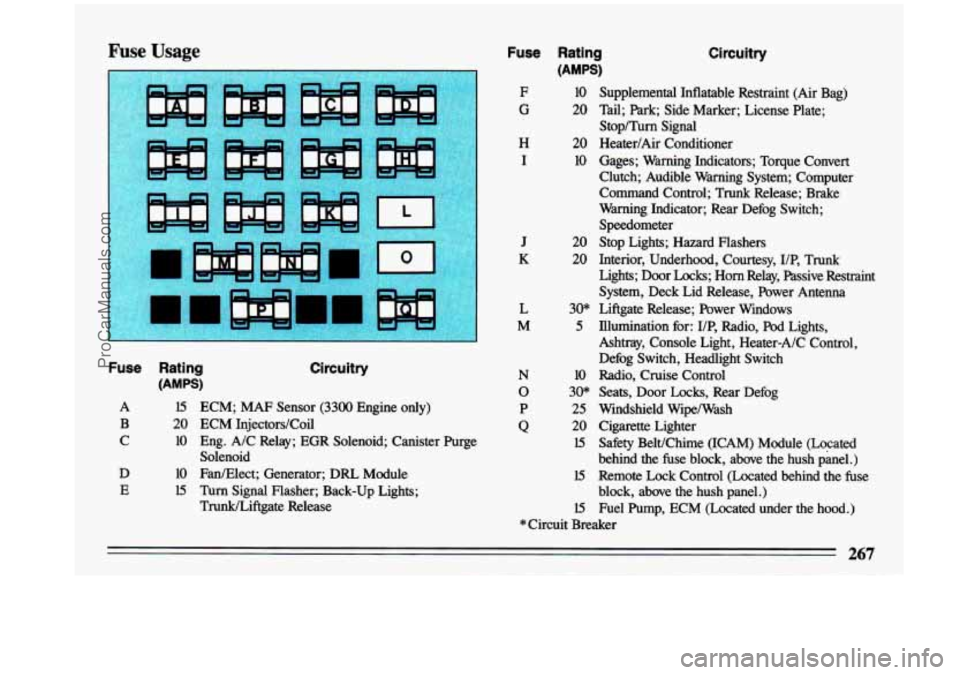
Fuse Usage
I
I
Fuse Rating
(AMPS)
A
B
C
D E
15
20
10
10
15
ECM; MAF Sensor (3300 Engine only)
ECM Injectors/Coil
Eng. A/C Relay; EGR Solenoid; Canister Purge Solenoid
Fan/Elect; Generator; DRL Module
Turn Signal Flasher; Back-up Lights;
TruWLiftgate Release
Fuse
F
G
H
I
J
K
L
M
Rating
(AMPS)
10
20
20
10
20
20
30"
5
Circuitry N
0
P
Q
10
30"
25
20
15
15
15
Circuitry
Supplemental Inflatable Restraint (Air Bagj
Tail; Park; Side Marker; License Plate; Stop/Turn Signal
Heater/Air Conditioner
Gages; Warning Indicators; Torque Convert
Clutch; Audible Warning System; Computer Command Control; Trunk Release; Brake
Warning Indicator; Rear Defog Switch;
Speedometer
Stop Lights; Hazard Flashers
Interior, Underhood, Courtesy, I/P, Trunk Lights; Door
Locks; Horn Relay, Passive Restraint
System, Deck Lid Release, Power Antenna
Liftgate Release; Power Windows
Illumination for: I/P, Radio,
Pod Lights,
Ashtray, Console Light, Heater-A/C Control,
Defog Switch, Headlight Switch
Radio, Cruise Control
Seats, Door
Locks, Rear Defog
Windshield Wipe/Wash
Cigarette Lighter
Safety Belt/Chirne (ICAM) Module (Located
behind the fuse block, above the hush panel.)
Remote Lock Control (Located behind the fuse
block, above the hush panel.) Fuel Pump, ECM (Located under the hood.)
*Circuit Breaker
267
ProCarManuals.com
Page 313 of 324
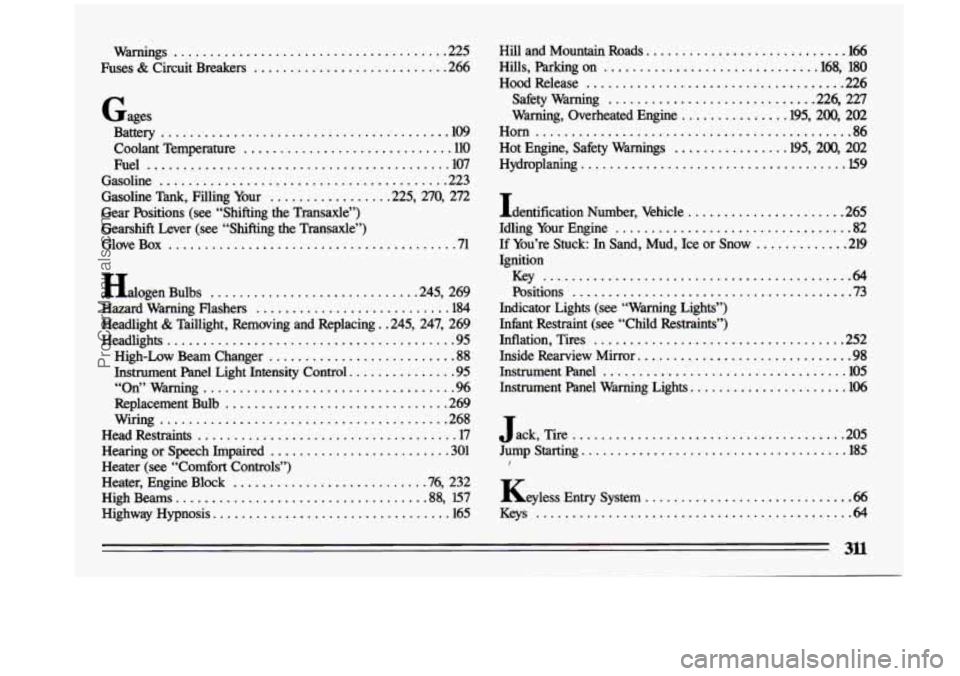
Warnings ...................................... 225
Fuses
& Circuit Breakers ........................... 266
Gages Battery
......................................... 109
Coolant Temperature
............................. 110
Fuel
.......................................... 107
Gasoline
........................................ 223
Gasoline Tank. Filling Your
................ .225. 270. 272
Gear Positions (see “Shifting the Transaxle”) Gearshift Lever
(see “Shifting the Transaxle”)
GloveBox
........................................ 71
Halogen Bulbs ............................ .245. 269
Hazard Warning Flashers
........................... 184
Headlight
& Taillight. Removing and Replacing . .245. 247. 269
Headlights
........................................ 95
High-Low Beam Changer
.......................... 88
Instrument Panel Light Intensity Control ............... 95
“0n”Warning
................................... 96
Replacement Bulb ............................... 269
Head Restraints
.................................... 17
Hearing or Speech Impaired
......................... 301
Heater (see “Comfort Controls”)
Heater, Engine Block
.......................... .76. 232
HighBeams
................................... 88, 157
Highway Hypnosis ................................. 165
Wiring
........................................ 268 HillandMountainRoads
............................ 166
Hills. Parking on ............................. .168. 180
Hood Release .................................... 226
Safety Warning
............................ .226. 227
Warning. Overheated Engine
.............. .195. 200. 202
Horn ............................................ 86
Hot Engine. Safety Warnings
............... .195. 200. 202
Hydroplaning ..................................... 159
Identification Number. Vehicle
...................... 265
Idling Your Engine
................................. 82
If You’re Stuck: In Sand. Mud. Ice or Snow ............. 219
Ignition Key
........................................... 64
Positions ....................................... 73
Indicator Lights
(see “Warning Lights”)
Infant Restraint (see “Child Restraints”)
Inflation. Tires
................................... 252
Inside Rearview Mirror
.............................. 98
Instrument Panel .................................. 105
Instrument Panel Warning Lights ...................... 106
...................................... J ack. Ti re 205
Jump Starting
..................................... 185
Keyless Entry System
............................. 66
I
Keys ............................................ 64
ProCarManuals.com